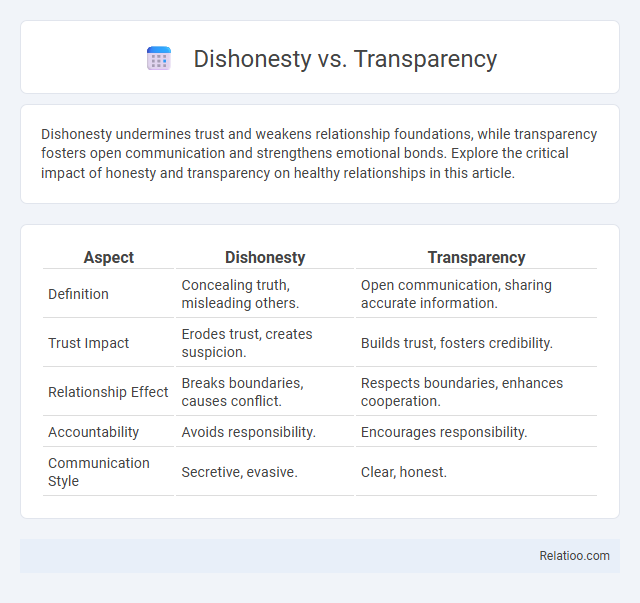Dishonesty undermines trust and weakens relationship foundations, while transparency fosters open communication and strengthens emotional bonds. Explore the critical impact of honesty and transparency on healthy relationships in this article.
Table of Comparison
| Aspect | Dishonesty | Transparency |
|---|---|---|
| Definition | Concealing truth, misleading others. | Open communication, sharing accurate information. |
| Trust Impact | Erodes trust, creates suspicion. | Builds trust, fosters credibility. |
| Relationship Effect | Breaks boundaries, causes conflict. | Respects boundaries, enhances cooperation. |
| Accountability | Avoids responsibility. | Encourages responsibility. |
| Communication Style | Secretive, evasive. | Clear, honest. |
Understanding Dishonesty and Transparency
Understanding dishonesty involves recognizing deceptive behaviors that undermine trust and damage relationships, while transparency promotes openness and accountability by sharing truthful information. Your ability to distinguish between these concepts enhances communication and fosters a culture of integrity in personal and professional settings. Emphasizing transparency helps prevent misunderstandings and builds stronger connections based on honesty.
Key Differences Between Dishonesty and Transparency
Dishonesty involves concealing or distorting information, leading to mistrust and ethical breaches, while transparency promotes openness and accountability by providing clear, accurate, and accessible information. Key differences between dishonesty and transparency include the intent to deceive versus the intent to inform, the impact on relationships and reputation, and the role in fostering trust within organizations or societies. Transparency enhances decision-making and collaboration by ensuring stakeholders have reliable data, whereas dishonesty undermines these processes by fostering confusion and suspicion.
The Root Causes of Dishonesty
The root causes of dishonesty often stem from fear of judgment, desire for personal gain, and lack of accountability, driving individuals to withhold or distort information. Transparency, by fostering open communication and trust, can mitigate these underlying factors by creating an environment where honesty is valued and reinforced. Understanding these psychological and social triggers is essential for developing effective strategies that promote ethical behavior and reduce deceptive practices.
The Value and Impact of Transparency
Transparency fosters trust by providing clear, honest communication and accountability within organizations and relationships. Its value lies in promoting ethical behavior, reducing misunderstandings, and enhancing decision-making through open access to information. The impact of transparency is evident in increased credibility, improved stakeholder engagement, and the prevention of dishonesty-driven conflicts.
Dishonesty in Personal Relationships
Dishonesty in personal relationships undermines trust, leading to emotional distance and conflict between partners, friends, or family members. Patterns of deceit, such as lying or withholding important information, erode intimacy and create a foundation of insecurity and suspicion. Transparency fosters understanding and connection, highlighting how dishonesty directly disrupts communication and long-term relationship stability.
Transparency in the Workplace
Transparency in the workplace fosters trust, enhances communication, and drives employee engagement by openly sharing information and decision-making processes. You benefit from a culture where honesty promotes accountability and reduces misunderstandings, leading to higher productivity and morale. Unlike dishonesty, transparency cultivates a positive environment where ethical behavior is the standard, ensuring long-term organizational success.
Consequences of Dishonesty on Trust
Dishonesty erodes trust by creating doubts about your integrity and reliability, leading to damaged relationships and lost opportunities. Transparency fosters open communication, which strengthens trust and promotes collaboration. When dishonesty prevails, it results in a breakdown of confidence that is difficult to repair, ultimately harming your reputation and success.
How Transparency Drives Accountability
Transparency drives accountability by fostering an environment where actions and decisions are openly shared, making dishonesty easier to detect and deter. Organizations that prioritize transparency build trust with stakeholders and empower you to hold leaders responsible for ethical conduct. This openness reduces the risk of deceit and promotes a culture of integrity essential for sustainable success.
Cultivating a Culture of Transparency
Cultivating a culture of transparency significantly reduces dishonesty by promoting open communication, accountability, and trust within organizations. Transparent practices enable employees to share information freely, address issues promptly, and foster ethical behavior, which minimizes opportunities for deceit. Organizations prioritizing transparency experience higher engagement, improved decision-making, and a positive reputation that counteracts the negative impact of dishonesty.
Overcoming Barriers to Honesty and Openness
Overcoming barriers to honesty and openness requires recognizing how dishonesty creates mistrust and hinders effective communication, while transparency builds credibility and fosters stronger relationships. Your commitment to transparency promotes a culture that encourages truthful dialogue, reduces misunderstandings, and supports ethical decision-making. Consistently choosing openness over dishonesty enables greater collaboration and long-term success both personally and professionally.

Infographic: Dishonesty vs Transparency
 relatioo.com
relatioo.com